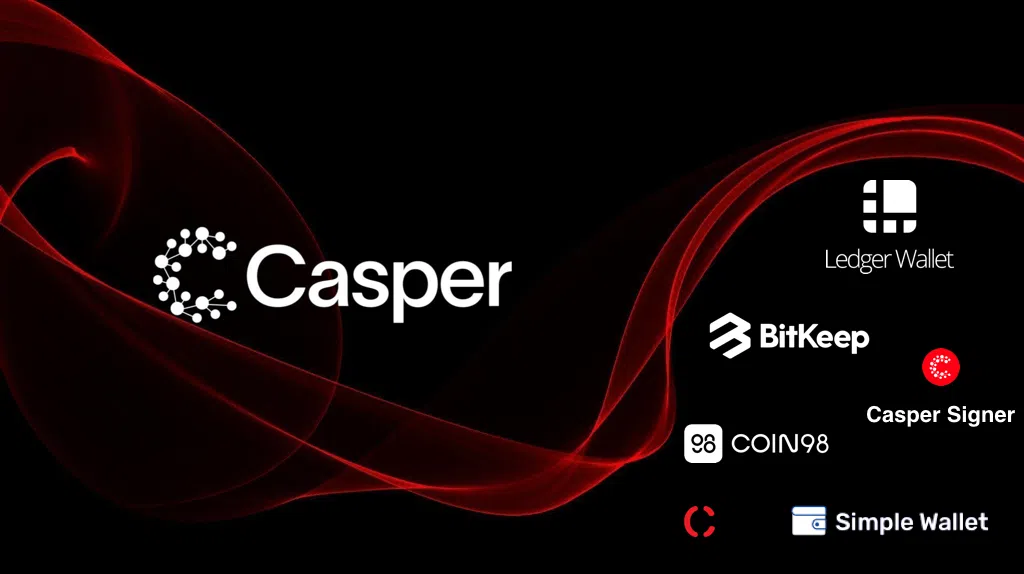Unlocking the Potential of Blockchain Technology with Casper Network

Blockchain technology stands as one of the most groundbreaking innovations of the 21st century, with the power to transform nearly every industry. As we delve deeper into its potential, new blockchain applications continue to emerge. Entrepreneurs, lawmakers, and investors are increasingly turning to blockchain to revolutionize how businesses interact with each other, government regulators, and their customers.
As more companies embrace blockchain technology, the ecosystem around it has become increasingly diverse and dynamic. Blockchain’s ability to foster decentralization, transparency, and immutability has sparked significant advancements across sectors such as finance, supply chain management, food safety, and insurance.
Table of Contents
Why Blockchain is a Game-Changer
Blockchain technology offers a unique ability to create decentralized ecosystems, ensuring trust, transparency, and the immutability of data. These characteristics are driving fundamental shifts in the technology landscape and enabling new business models that were previously unattainable.
For instance, blockchain enables greater transparency in supply chains, ensuring that products can be traced from their origin to the consumer. In the finance sector, it reduces fraud, enhances security, and improves the efficiency of transactions. Blockchain’s potential applications are virtually limitless, spanning industries far beyond these examples.
Introducing the Casper Network: A New Era of Blockchain Innovation
One of the most exciting blockchain projects to emerge recently is the Casper Network. This innovative platform is pushing the boundaries of what blockchain technology can achieve. Built to scale, the Casper Network is designed to drive adoption across a wide range of industries by offering flexibility, security, and a developer-friendly environment.
What is Casper Network?
Founded in 2018 by Medha Parlikar and Mrinal Manohar, Casper Network is the first real-time Proof-of-Stake (PoS) blockchain based on the Casper CBC (Correct-by-Construction) specification. Its mission is to drive the global adoption of blockchain technology, smart contracts, and decentralized applications (DApps) through a future-oriented and developer-friendly platform. Casper’s innovative architecture ensures continuous development in line with evolving user demands and the diverse needs of developers, making it a standout choice in the blockchain landscape.
The Vision Behind Casper
Casper has been designed with businesses and developers in mind, with a focus on creating a blockchain solution that evolves with the ever-growing needs of Web3. According to Casper’s official whitepaper, the platform is optimized to meet the demands of enterprises and developers alike, facilitating the integration of blockchain in real-world applications. As the demand for intuitive and interconnected services rises, Casper aims to lead the charge in ushering in the next era of Web3.
The key to Casper’s value proposition lies in its ability to solve the “adoption trilemma,” providing enterprise-level security, scalability, and decentralization on a single blockchain protocol. This ensures that enterprises can leverage the network with confidence, knowing that it meets critical performance and security standards.
Casper’s Unique Consensus Protocol: Highway
At the core of Casper’s functionality is its Highway consensus protocol, which sets it apart from other blockchain networks. Built on the foundations of Vlad Zamfir’s CBC Casper research, the Highway protocol offers several advantages over traditional Byzantine Fault Tolerant (BFT) consensus mechanisms.
One of the primary benefits of the Highway protocol is its ability to finalize blocks more effectively. Unlike classic BFT protocols, Highway allows the network to reach a higher threshold of finalization, enabling validators to more easily agree on which blocks should be added to the blockchain. This results in a more efficient and secure process for maintaining the integrity of the network.
Another notable advantage of the Highway protocol is its flexibility in block finalization, a feature that cannot be achieved with standard BFT consensus models. This flexibility enhances the overall performance of the Casper Network, making it a more versatile and robust option for enterprises and developers.
Why Casper Stands Out: Developer-Friendly and Enterprise-Ready
The Casper Network was specifically designed with the adoption needs of developers and enterprises in mind. It offers a host of features aimed at pushing business operations forward, including predictable network fees, privacy flexibility, upgradeable smart contracts, and on-chain governance. These attributes make Casper an attractive option for businesses seeking to implement blockchain solutions without the uncertainty or complexity often associated with blockchain technology.
Moreover, Casper addresses one of the most pressing challenges in the blockchain space: scalability. By optimizing the network for security, high throughput, and decentralization, Casper provides a scalable solution that evolves with the changing needs of its users. This continual evolution ensures that the network remains at the forefront of blockchain innovation, offering solutions that cater to both large enterprises and open-source projects alike.
The Benefits of Choosing Casper
With its advanced consensus protocol, scalability solutions, and enterprise-ready features, Casper provides a strong value proposition for businesses and developers seeking to harness the power of blockchain technology. Its combination of security, decentralization, and flexibility positions it as a leading platform in the blockchain space.
How is Casper Beneficial?
Casper Network’s core attributes offer significant advantages to developers and enterprises looking to leverage blockchain technology. One of its standout features is the ability to directly upgrade smart contracts on-chain without the need for complex migrations, simplifying the process of fixing vulnerabilities and enhancing security. Below, we explore some of the key benefits Casper brings to the table:
1. Developer-Friendly Ecosystem
Casper supports WebAssembly (WASM), a widely-used development standard, rather than relying on proprietary languages like Solidity. This approach streamlines the development process for companies and developers, making it easier for teams to build on the Casper Network without needing to learn a new, specialized language. By utilizing a familiar language like WASM, Casper reduces barriers to entry and enables faster adoption by developers across different industries.
2. Advanced Account Management
Casper includes advanced features for account management, such as an account permission model that allows for the recovery of lost keys. Additionally, it provides a secure model for sharing state between accounts and contracts without the need for costly encryption control. These functions enhance security and efficiency, making the platform more user-friendly and accessible for both developers and enterprises.
3. Predictable Network Fees
One of the major pain points in blockchain development is the unpredictability of transaction fees. Casper addresses this issue by offering transparent, consistent, and predictable network fees. This eliminates the volatility commonly seen in gas prices on other blockchain networks, allowing developers and businesses to plan and operate with greater financial certainty. This feature promotes a more active and diverse network ecosystem by fostering better financial management for users.

How Does Casper Network Work?
The Casper Network operates using a group of validators who are responsible for validating transactions and maintaining the network. Unlike Proof-of-Work (PoW) systems, which tend to centralize validators to achieve economies of scale, Casper leverages a geographically decentralized network of validators. This allows Casper to maintain decentralization without the need for the high-energy costs associated with PoW networks.
Casper’s validators verify transactions by staking tokens and are rewarded in CSPR, the native token of the network, based on their participation in the Proof-of-Stake (PoS) consensus mechanism. Validators play a crucial role in securing the network and ensuring that only legitimate transactions are recorded on the blockchain.
How Does Casper Network Communicate?
Network Communication
Casper’s network is composed of nodes, which communicate with one another to reach consensus on the blockchain’s state. Each node is seen as a unique entity within the network, even though it may not correspond to a single physical machine. Nodes have a distinct ID and address, making them appear as independent logical entities to their peers.
Identity
Every node on the Casper network is assigned a unique identity, which differs from its role in the consensus process. This identity is derived from the public key fingerprint of a self-signed TLS certificate. Each time a node is started, it generates a new private key, ensuring that every node has a unique identity. Each identity is paired with an endpoint, which consists of an IP address and port numbers that allow other nodes to locate and connect to it.
Inter-Node Connections
When one node wishes to connect with another, it uses the known endpoint address to establish a TLS connection. In this process, the connecting node acts as the client, while the remote node assumes the role of the server. During this connection, the client verifies the server’s certificate to ensure that it is connecting to the correct node. Both nodes exchange certificates, confirming each other’s identity before the connection is finalized.
Once connected, the nodes begin communication by sending one-way messages across the network. If a two-way connection cannot be established within a specific time frame, the connection is terminated, and the node will attempt to reconnect later.
How Data is Distributed Across the Casper Network
Network Formation
Nodes within the Casper Network actively seek out and connect to other nodes to form a fully connected network. Once connected, these nodes participate in node discovery, where they share public addresses with one another. The Casper Network supports two types of data transmission: broadcast and gossip.
-
Broadcast: This is a one-time message sent to all connected nodes without a guarantee of delivery. Typically, only consensus messages from active validators are broadcasted.
-
Gossip: Gossiping is the primary method used by nodes to share data, such as blocks, implementations, and endpoints. The objects shared through gossip are immutable and are identified by a unique hash.
Gossip Protocol
The gossip protocol allows data to be distributed throughout the network in a more efficient manner, without sending it directly to every node. Instead, only a subset of nodes receives the data and then shares it with others, distributing the load across the network. This method helps minimize bandwidth and processing demands but may introduce some delay in the distribution of information.
When nodes gossip about blocks or other objects, they check the validity of these objects by ensuring that all dependencies are met. For instance, a block relies on the implementations referenced within it. If a node is missing any dependencies, it pauses the gossip process until it retrieves all necessary data. Nodes are responsible only for broadcasting validated objects; if a node fails to retrieve missing dependencies from a peer, it can penalize that peer.
Node Discovery
Node discovery is an ongoing process where each node periodically shares its public address. Upon receiving this address through the gossip protocol, other nodes will attempt to establish a connection. If successful, the node records the endpoint for future communication. This continuous discovery process ensures that the network remains robust and that all nodes stay connected.
Conclusion: The Mechanics of the Casper Network
The Casper Network employs a highly decentralized and secure system that relies on validators to maintain the network, leveraging Proof-of-Stake to minimize energy usage while ensuring transaction validation. Through a sophisticated system of node connections, gossip protocols, and consensus mechanisms, Casper ensures that data is efficiently and securely distributed across its network. This architecture makes Casper a scalable, secure, and decentralized blockchain solution tailored for both developers and enterprises alike.
Recent Insights:

The Benefits and Drawbacks of Computer-Assisted Learning
The Benefits and Drawbacks of Computer-Assisted LearningComputer-assisted learning (CAL) is revolutionizing education by enhancing both teaching and learning processes, resulting in higher engagement and better outcomes. However, despite its...

Consumer Token Offerings (CTO): Benefits, Use Cases, and Growth
CTO Crypto Meaning: Understanding Consumer Token OfferingsThe cryptocurrency landscape has rapidly evolved, transitioning from Initial Coin Offerings (ICOs) to Security Token Offerings (STOs), leading to the emergence of Consumer Token Offerings...

Web3 AI: How AI Appears in the Web3 World
Web3 AI: How AI Appears in the Web3 WorldAs we stand on the brink of a transformative technological era, industry experts predict a monumental shift in a significant portion of the world's software, with AI and machine learning (ML) emerging as...
Contact Us
Info@DigitalOriginTech.com
Get all your questions answered by our team.
F&Q
What is the Casper Network?
The Casper Network is a decentralized Proof-of-Stake (PoS) blockchain that uses a group of validators to verify transactions. It is designed for developer and enterprise adoption, offering features like smart contract upgrades and predictable network fees.

